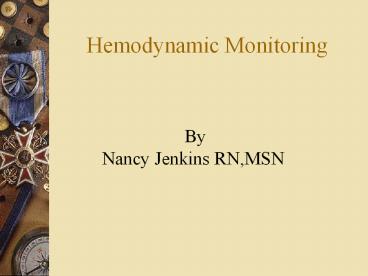Hemodynamic Monitoring - PowerPoint PPT Presentation
1 / 42
Title:
Hemodynamic Monitoring
Description:
By Nancy Jenkins RN,MSN What is Hemodynamic Monitoring? Hemodynamic Monitoring Baseline data obtained (low cardiac output) General appearance Level of consciousness ... – PowerPoint PPT presentation
Number of Views:543
Avg rating:3.0/5.0
Title: Hemodynamic Monitoring
1
Hemodynamic Monitoring
By Nancy Jenkins RN,MSN
2
What is Hemodynamic Monitoring?
It is measuring the pressures in the heart
3
Hemodynamic Monitoring
- Baseline data obtained (low cardiac output)
- General appearance
- Level of consciousness
- Skin color/temperature
- Vital signs
- Peripheral pulses
- Urine output
4
Hemodynamic Monitoring
- Baseline data correlated with data obtained from
technology (e.g., ECG arterial, CVP, PA, and
PAWP pressures - Look at trends!!
5
Purpose of Hemodynamic Monitoring
- Evaluate cardiovascular system
- Pressure, flow, resistance
- Establish baseline values and evaluate trends
- Determine presence and degree of dysfunction
- Implement and guide interventions early to
prevent problems
6
Hemodynamic Monitoring Components
Heart Rate Blood Pressure and MAP CVP Pulmonary
Artery Pressures Systemic Vascular Pressure
(SVR) Pulmonary Vascular Pressure (PVR) Cardiac
Output/ Cardiac Index Stroke Volume
7
(No Transcript)
8
Comparing Hemodynamics to IV pump
- Fluid preload
- Pump CO or contractility (needs electricity)
- Tubing afterload
9
(No Transcript)
10
(No Transcript)
11
Types of Invasive Pressure Monitoring
- Continuous arterial pressure monitoring
- Acute hypertension/hypotension
- Respiratory failure
- Shock
- Neurologic shock
12
Types of Invasive Pressure Monitoring
- Continuous arterial pressure monitoring (contd)
- Coronary interventional procedures
- Continuous infusion of vasoactive drugs
- Frequent ABG sampling
13
Components of an Arterial Pressure Monitoring
System
Fig. 66-3
14
Arterial Line
15
Arterial Pressure Monitoring
- High- and low-pressure alarms based on patients
status - Risks
- Hemorrhage, infection, thrombus formation,
neurovascular impairment, loss of limb (Assess 5
Ps)
16
Arterial Pressure Tracing
Fig. 66-6
17
(No Transcript)
18
(No Transcript)
19
Dicrotic notch signifies the closure of the
aortic valve.
20
Pulmonary Artery Pressure Monitoring
- Guides management of patients with complicated
cardiac, pulmonary, and intravascular volume
problems - PA diastolic (PAD) pressure and PAWP Indicators
of cardiac function and fluid volume status - Monitoring PA pressures allows for therapeutic
manipulation of preload
21
Pulmonary Artery Pressure Monitoring
- PA flow-directed catheter
- Distal lumen port in PA
- Samples mixed venous blood
- Thermistor lumen port near distal tip
- Monitors core temperature
- Thermodilution method measuring CO
22
Pulmonary Artery Pressure Monitoring
- Right atrium port
- Measurement of CVP
- Injection of fluid for CO measurement
- Blood sampling
- Administer medications
23
Pulmonary Artery Catheter
Fig. 66-7
24
(No Transcript)
25
(No Transcript)
26
(No Transcript)
27
(No Transcript)
28
PA Waveforms during Insertion
Fig. 66-9
29
(No Transcript)
30
Hemodynamics Normal value
Mean Arterial Pressure (MAP) 70 -90 mm Hg Cardiac
Index (CI)- 2.2-4.0 L/min/m2 Cardiac Output
(CO)- 4-8 L/min Central Venous Pressure (CVP)
(also known as Right Atrial Pressure (RA)) 2-8
mmHg Pulmonary Artery Pressure (PA) Systolic
20-30 mmHg (PAS)Diastolic 4-12 mmHg (PAD)Mean
15-25 mmHg Pulmonary Capillary Wedge Pressure
(PWCP) 6-12 mmHg Systemic Vascular
Resistance(SVR) 800-1200
31
Cardiac Output
http//www.lidco.com/docs/Brochure.pdf
32
Measuring Cardiac Output
- Intermittent bolus thermodilution method
- Continuous cardiac output method
33
Measuring Cardiac Output
- SVR, SVRI, SV, and SVI can be calculated when CO
is measured - ? SVR
- Vasoconstriction from shock
- Hypertension
- ? Release or administration of epinephrine or
other vasoactive inotropes - Left ventricular failure
34
Best indicator of tissue perfusion. Needs to be
at least 60 to perfuse organs
35
(No Transcript)
36
Complications with PA Catheters
- Infection and sepsis
- Asepsis for insertion and maintenance of catheter
and tubing mandatory - Change flush bag, pressure tubing, transducer,
and stopcock every 96 hours - Air embolus (e.g., disconnection)
37
Complications with PA Catheters
- Ventricular dysrhythmias
- During PA catheter insertion or removal
- If tip migrates back from PA to right ventricle
- PA catheter cannot be wedged
- May need repositioning
38
Complications with PA Catheters
- Pulmonary infarction or PA rupture
- Balloon rupture (e.g., overinflation)
- Prolonged inflation
- Spontaneous wedging
- Thrombus/embolus formation
39
(No Transcript)
40
Noninvasive Hemodynamic Monitoring
- Impedance cardiography (ICG)
- Continuous or intermittent, noninvasive method of
obtaining CO and assessing thoracic fluid status
41
Noninvasive Hemodynamic Monitoring
- Major indications
- Early signs and symptoms of pulmonary or cardiac
dysfunction - Differentiation of cardiac or pulmonary cause of
shortness of breath - Evaluation of etiology and management of
hypotension
42
Noninvasive Hemodynamic Monitoring
- Major indications (contd)
- Monitoring after discontinuing a PA catheter or
justification for insertion of a PA catheter - Evaluation of pharmacotherapy
- Diagnosis of rejection following cardiac
transplantation
hemodynamic cases































